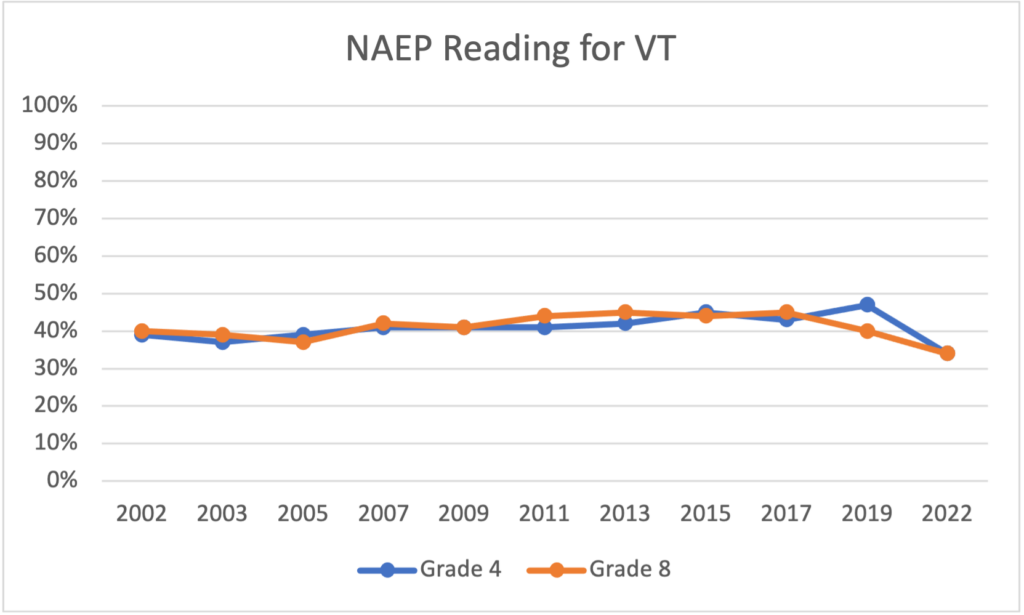The prevailing narrative is that the pandemic shutdowns affected student performance in public schools. As seen in our prior two articles, data from the Croydon, NH Village School, and statewide data from the New Hampshire Student Assessment System (NHSAS), the National Assessment of Educational Progress test do not support this narrative.
The data clearly shows that reading scores were decreasing well before the pandemic. Moreover, it also showed conclusively that fewer than half of NH’s students had been scoring proficient or better for decades.
In this article, we take an in-depth look at what happened to performance before and after the pandemic shutdowns in Vermont, using its statewide test, the Smarter Balanced Assessment Consortium (SBAC), and the NAEP test.
Vermont students have taken the SBAC every year in grades 3 through 9 since 2015. The tests were not administered in 2020 because of the school shutdowns caused by the COVID pandemic. In 2021, the SBAC was optional. Scores for 2023 are not yet available. The VT Agency of Education did not respond to a request for this data. However, because VT changed to the Cognia test, it would be hard to compare the 2023 results to previous years’ SBAC scores.
The VT SBAC Reading chart (below) shows the percentage of students in grades 3 through 9 who performed at or above proficiency in reading from 2018 to 2022. In 2022, just over 40% of 3rd-grade students (bottom line in chart) were considered proficient or above in reading. That means 60% of students were reading below grade level, a full year after returning to in-person schooling.
Performance in 2021 was better than in 2022, which is hard to explain. The chart shows that pre-pandemic performance had been poor since at least 2018, with about 50% of 3rd-grade students (bottom line in the chart) scoring proficient or above in reading. Though a ten-point drop is pretty significant, the fact remains that about half of Vermont’s students were not able to read at grade level before the pandemic. The chart shows a steady decline since 2018 for most grades, with all of them doing poorly across the years.
As we know, student ability can’t be measured by just one test. So, as we did with New Hampshire, we will look at how Vermont’s students did on a national test.
The National Assessment of Educational Progress (NAEP, pronounced “nape”) is often called “The Nation’s Report Card.” Since 1969, NAEP has been designed and used by the education establishment to let everyone know how well the United States is educating its children. They report results for each state for grades 4 and 8.
According to this test, Vermont students are about average compared to other states.
Vermont has NAEP scores for grades 4 and 8 in reading and math since 2002. In reading, as shown in the NAEP Reading chart (below), the number of students reading at or above proficient for grades 4 (blue line) and 8 (orange line) hovered around 40% from 2002 to 2019.
The grade 8 scores started to go down in 2019, before the pandemic. While shutdown affected the grade 4 scores a little, the data shows that the scores have been poor for over 20 years. Since 2002, around 60% of Vermont’s students have not been able to read at grade level. In 2022, the number edged closer to 65%.
As with New Hampshire, Vermont’s data shows dismal proficiency rates that stretch back more than twenty years. That Vermont made its state test optional in 2021 complicates the picture because that testing cohort deviates from the norm. However, Vermont’s data does show that if the scores got worse, it wasn’t by much. This is important because the narrative that “things got worse” suggests that things were going fine before when they weren’t.
This story is part of a series where we show how the pandemic shutdowns in Vermont and New Hampshire affected student performance on state and national standardized tests. Prior installments in this series were published in the Eagle Times on September 9 and 12 and in Grok part 1 and part 2.
Next, we’ll take a look at test scores and reading instruction at Killington Elementary School in Killington, VT.
This article first appeared in the Eagle Times and was edited slightly.


